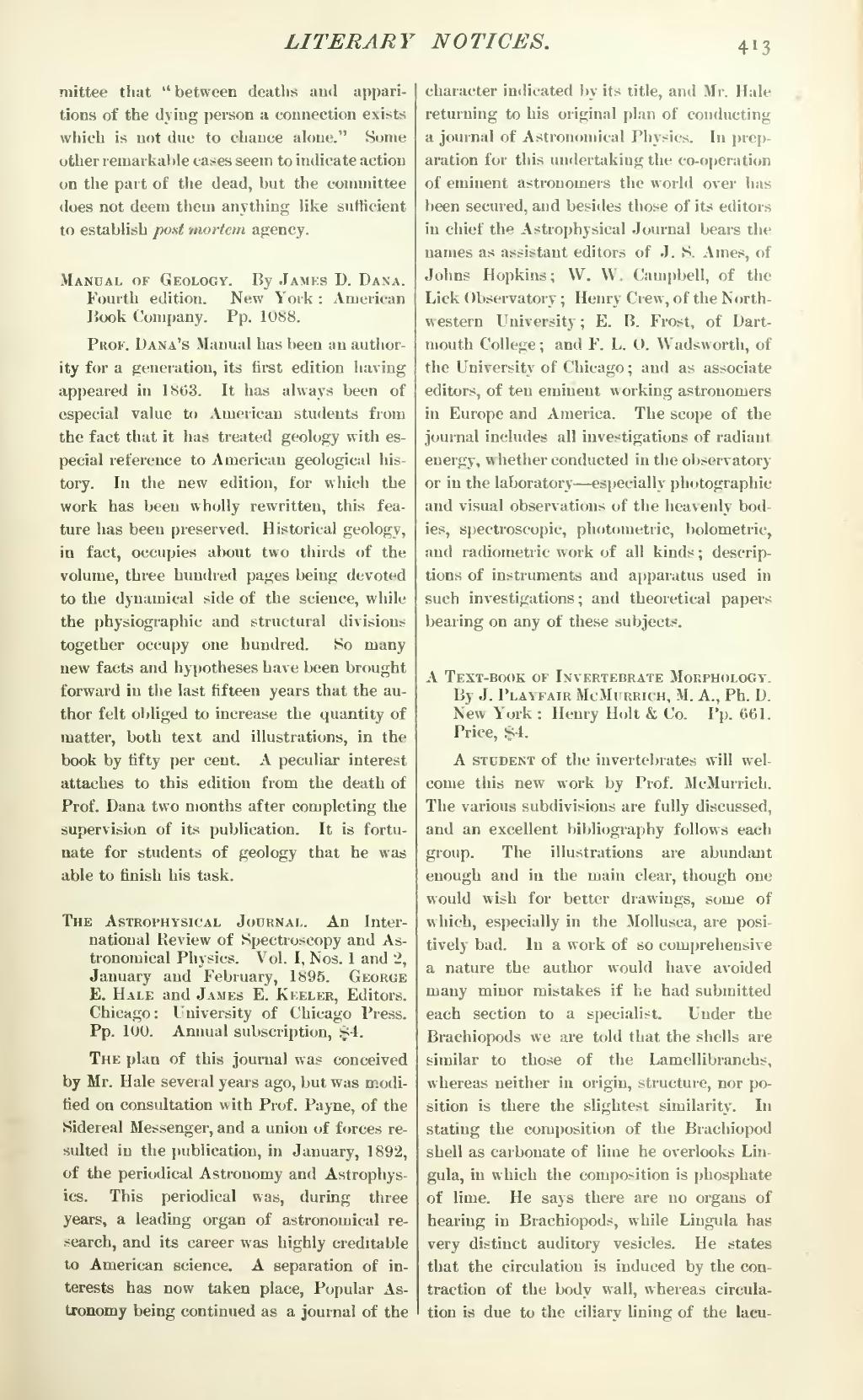mittee that "between deaths and apparitions of the dying person a connection exists which is not due to chance alone." Some other remarkable cases seem to indicate action on the part of the dead, but the committee does not deem them anything like sufficient to establish post mortem agency.
Manual of Geology. By James D. Dana. Fourth edition. New York: American Book Company. Pp. 1088.
Prof. Dana's Manual has been an authority for a generation, its first edition having appeared in 1863. It has always been of especial value to American students from the fact that it has treated geology with especial reference to American geological history. In the new edition, for which the work has been wholly rewritten, this feature has been preserved. Historical geology, in fact, occupies about two thirds of the volume, three hundred pages being devoted to the dynamical side of 'the science, while the physiographic and structural divisions together occupy one hundred. So many new facts and hypotheses have been brought forward in the last fifteen years that the author felt obliged to increase the quantity of matter, both text and illustrations, in the book by fifty per cent. A peculiar interest attaches to this edition from the death of Prof. Dana two months after completing the supervision of its publication. It is fortunate for students of geology that he was able to finish his task.
The Astrophysical Journal. An International Review of Spectroscopy and Astronomical Physics. Vol. I, Nos. 1 and 2, January and February, 1895. George E. Hale and James E. Keeler, Editors. Chicago: University of Chicago Press. Pp. 100. Annual subscription, $4.
The plan of this journal was conceived by Mr. Hale several years ago, but was modified on consultation with Prof. Payne, of the Sidereal Messenger, and a union of forces resulted in the publication, in January, 1892, of the periodical Astronomy and Astrophysics. This periodical was, during three years, a leading organ of astronomical research, and its career was highly creditable to American science. A separation of interests has now taken place, Popular Astronomy being continued as a journal of the character indicated by its title, and Mr. Hale returning to his original plan of conducting a journal of Astronomical Physics. In preparation for this undertaking the co-operation of eminent astronomers the world over has been secured, and besides those of its editors in chief the Astrophysical Journal bears the names as assistant editors of J. S. Ames, of Johns Hopkins; W. W. Campbell, of the Lick Observatory; Henry Crew, of the Northwestern University; E. B. Frost, of Dartmouth College; and F. L. 0. Wadsworth, of the University of Chicago; and as associate editors, of ten eminent working astronomers in Europe and America. The scope of the journal includes all investigations of radiant energy, whether conducted in the observatory or in the laboratory—especially photographic and visual observations of the heavenly bodies, spectroscopic, photometric, bolometric, and radiometric work of all kinds; descriptions of instruments and apparatus used in such investigations; and theoretical papers bearing on any of these subjects.
A Text-book of Invertebrate Morphology. By J. Playfair McMurrich, M. A., Ph. D. New York: Henry Holt & Co. Pp. 661. Price, $4.
A student of the invertebrates will welcome this new work by Prof. McMurrich. The various subdivisions are fully discussed, and an excellent bibliography follows each group. The illustrations are abundant enough and in the main clear, though one would wish for better drawings, some of which, especially in the Mollusca, are positively bad. In a work of so comprehensive a nature the author would have avoided many minor mistakes if he had submitted each section to a specialist. Under the Brachiopods we are told that the shells are similar to those of the Lamellibranchs, whereas neither in origin, structure, nor position is there the slightest similarity. In stating the composition of the Brachiopod shell as carbonate of lime he overlooks Lingula, in which the composition is phosphate of lime. He says there are no organs of hearing in Brachiopods, while Lingula has very distinct auditory vesicles. He states that the circulation is induced by the contraction of the body wall, whereas circulation is due to the ciliary lining of the lacu-
